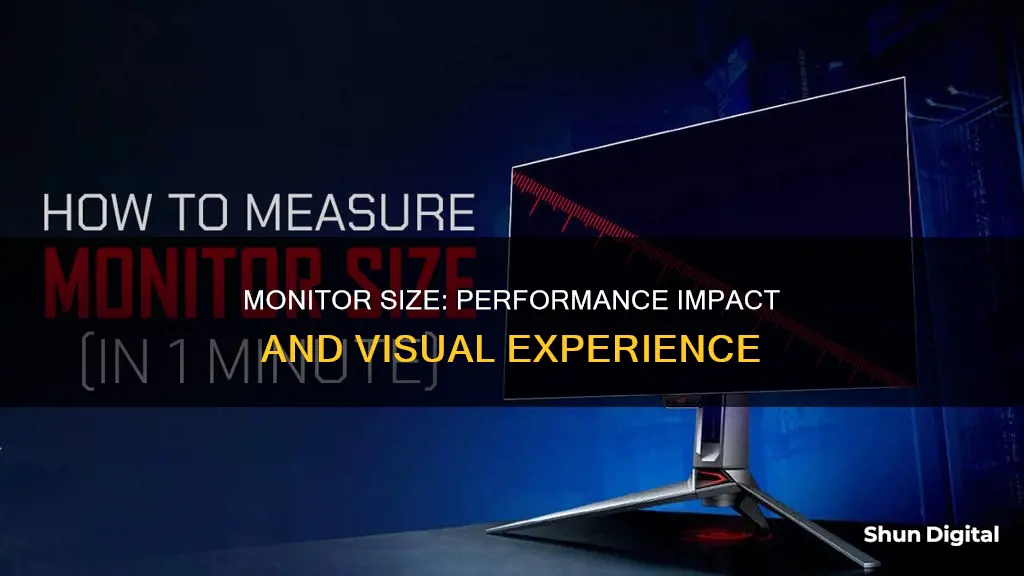
The size of a monitor does not affect its performance. However, the resolution and refresh rate do. A higher resolution means that the GPU has to work harder to render more pixels, which can lead to decreased performance. A higher refresh rate means that the GPU has to generate new frames more frequently, which can also impact performance. The physical size of the monitor does not change the signal coming out of the computer. Instead, it is the resolution and refresh rate that determine how much data the computer has to construct for each frame.
| Characteristics | Values |
|---|---|
| Physical dimensions | Measured diagonally from one corner to the opposite corner |
| Impact on computing experience | Larger monitors offer more space for multitasking and enhance immersion in activities like gaming and movie-watching |
| Gaming experience | A wider field of view and more immersive gameplay |
| Productivity | Larger monitors allow for easier multitasking and boost productivity |
| Resolution | Larger monitors often come with higher resolutions to maintain image clarity |
| Movie-watching experience | A more immersive viewing experience with better detail and clarity |
| Text readability | Larger monitors display text larger and clearer |
| Ergonomics | Larger monitors may require adjustments to desk setup for proper ergonomic alignment |
| Desk space | Smaller monitors save physical space on the desk |
| Performance | Monitor size itself doesn't directly affect performance, but a larger size can change the gaming experience by providing a wider field of view and greater detail |
What You'll Learn
- Ultrawide monitors have a larger resolution, which can affect gaming performance
- The number of pixels on a monitor affects performance
- A monitor's resolution determines the number of pixels that need to be processed, impacting performance
- A larger monitor with a higher resolution can decrease performance in all games
- A monitor's physical size does not impact performance, but its resolution does

Ultrawide monitors have a larger resolution, which can affect gaming performance
Ultrawide monitors offer a more immersive gaming experience, with a wider field of view and greater detail, enhancing the player's situational awareness and boosting their enjoyment. However, this increased screen real estate comes at a cost. Ultrawide monitors typically have a higher resolution, which can affect gaming performance by demanding more processing power from your graphics card.
The impact on performance is directly related to the number of pixels that need to be processed. A higher resolution means more pixels, which in turn requires more processing power and can lead to a drop in frames per second (FPS). The extent of the performance impact depends on the specific hardware setup, with more powerful graphics cards being able to handle higher resolutions with less of a performance hit.
For example, consider a setup with a GTX 960 2GB graphics card. When switching from a standard 1920x1080 resolution monitor to an ultrawide 2560x1080 resolution monitor, the performance impact will be more than a 1-3 FPS loss. The higher resolution will demand more processing power, resulting in a performance closer to that of a 2560x1440 resolution on a standard monitor.
It's important to note that not all games are optimised for ultrawide resolutions. While most modern games support 21:9 aspect ratios, some games may not support it out of the box or may require third-party tools to work properly. Additionally, some games may support ultrawide resolutions during gameplay but revert to a 16:9 aspect ratio for cutscenes and menus, disrupting the immersion.
To summarise, while ultrawide monitors offer a more immersive gaming experience, the higher resolution can affect gaming performance, particularly for setups with less powerful hardware. It's crucial to ensure that your hardware is capable of handling the increased resolution demands of an ultrawide monitor to avoid significant performance issues.
Hotels and Internet Privacy: Monitoring Guest Online Activity
You may want to see also

The number of pixels on a monitor affects performance
The number of pixels on a monitor does affect its performance. A monitor with a higher resolution will have more pixels, which means the graphics card has to work harder to process and render each frame. This can result in a decrease in performance, with the computer having to work harder to produce a larger image.
For example, a monitor with a resolution of 1920x1080 (2,073,600 pixels) will have significantly more pixels than a monitor with a resolution of 1280x720 (921,600 pixels). The former has over double the number of pixels, which can lead to a noticeable performance impact, especially for lower-spec computers.
However, it's important to note that the physical size of the monitor itself does not directly affect performance. Instead, it's the resolution (the number of pixels) that matters. A 32" monitor with a 1080p resolution will have the same number of pixels as a 24" monitor with the same resolution, and therefore the performance will be similar.
When choosing a monitor, it's crucial to consider the balance between size and resolution. While a larger monitor can provide a more immersive experience, it may require a higher resolution to maintain image quality. Additionally, the computer's hardware, especially the graphics card, should be capable of handling the increased workload that comes with higher resolutions.
In summary, the number of pixels on a monitor does affect performance, and it's important to consider the specifications of both the monitor and the computer to ensure optimal performance for your specific setup.
Hooking Up Your GameCube to an ASUS Monitor
You may want to see also

A monitor's resolution determines the number of pixels that need to be processed, impacting performance
A monitor's resolution determines the number of pixels that need to be processed, which in turn impacts performance. The relationship between screen resolution and performance is directly proportional; as the resolution increases, so does the number of pixels that need to be processed, leading to a potential decrease in performance. This is because each pixel requires individual processing, and in the case of complex 3D rendering, each pixel may need to be recalculated and reprocessed multiple times as various effects are applied.
The impact of resolution on performance can be understood by considering the quadratic increase in the number of pixels when both the width and height of a monitor increase symmetrically. For example, upgrading from a 500x500 resolution to 1000x1000 results in four times the number of pixels, not just double. This increase in pixels means more data to be processed, which can lead to a decrease in performance, especially for modern games that demand high frame rates.
The performance impact of higher resolutions is further influenced by the capabilities of the graphics card and its available video memory. When using a higher resolution, the graphics card needs to "create" more pixels for each frame, requiring additional processing power. This can result in a general decrease in performance across all games played at the monitor's full resolution. However, it's important to note that the physical size of the monitor itself does not directly affect performance, as long as the resolution remains the same.
The performance implications of monitor resolution become particularly noticeable in gaming scenarios, where the graphics card is pushed to its limits. In such cases, a higher resolution can lead to a more significant decrease in frames per second (FPS), affecting the overall gaming experience. Additionally, certain games with complex graphics and a large number of on-screen elements may be more demanding on the graphics card, exacerbating the performance impact of higher resolutions.
To mitigate the potential performance decrease associated with higher resolutions, it is essential to have adequate hardware. A powerful graphics card with sufficient video memory can handle the increased processing demands of higher resolutions more effectively, minimizing the impact on performance. Furthermore, certain settings within games, such as reducing the quality or resolution, can also help improve performance when using larger monitors with higher resolutions.
Understanding Trace Free Technology on ASUS Monitors
You may want to see also

A larger monitor with a higher resolution can decrease performance in all games
A larger monitor does not inherently decrease gaming performance. The performance of a game is tied to the resolution of the display, not the size of the screen. A higher resolution means the computer has to construct more data for every frame, which can lead to a drop in frames per second. This is because, at a constant frame rate, a higher resolution display requires significantly more data per frame than a lower resolution one. If the computer's CPU is not powerful enough, it will not be able to keep up with the required processing demands, resulting in lower frames per second and reduced performance.
However, if the resolution remains the same, increasing the monitor size will not affect gaming performance. The physical size of the monitor does not change the signal that comes out of the computer. The signal is only dependent on the resolution and the refresh rate. Therefore, the performance will remain the same whether you are using a 17-inch LCD display or projecting the image onto a 10-foot-wide movie screen, as long as the resolution and refresh rate are unchanged.
It is worth noting that a larger monitor with a higher resolution can provide a more immersive gaming experience by offering a wider field of view and greater detail. This can enhance the enjoyment of the game, even if the performance, in terms of frames per second, may be slightly lower. Additionally, the impact of a higher resolution on performance can be mitigated by dropping the quality or resolution settings in-game, depending on the specific game.
In summary, while a larger monitor with a higher resolution can decrease performance in all games due to the increased processing demands, it is not solely due to the size of the monitor but the combination of size and resolution. The physical size of the monitor, when the resolution remains the same, does not affect gaming performance.
Troubleshooting an ASUS Monitor: Persistent Flickering Issue
You may want to see also

A monitor's physical size does not impact performance, but its resolution does
The physical size of a monitor does not impact its performance. However, its resolution does. A larger monitor with a higher resolution will have more pixels, which means more processing power and can affect the output of the graphics card. This results in a general decrease in performance across all applications and games, as the graphics card has to work harder to produce a larger image.
For example, when upgrading from a standard 16:10 1440p monitor to an ultrawide 1440p monitor, the number of pixels increases, requiring more processing power and potentially impacting the frames per second (FPS) output. However, the drop in FPS is not linear and can be mitigated by adjusting the game settings.
Additionally, the physical size of a monitor can affect the ergonomics of your workspace and the viewing distance required for comfortable use. A larger monitor may require adjustments to your desk setup, such as changing the viewing distance or height to maintain proper alignment and reduce eye strain.
In summary, while the physical size of a monitor does not directly influence performance, the associated increase in resolution will impact the graphics card's processing requirements, leading to a potential decrease in overall performance.
Monitoring Gas Usage: Individual Apartment Solutions
You may want to see also
Frequently asked questions
Monitor size itself does not directly affect gaming performance. However, a larger monitor can enhance your gaming experience by providing a wider field of view and greater detail, thus improving immersion and situational awareness in games.
Not necessarily. Resolution refers to the number of pixels, while size refers to the physical dimensions. However, larger monitors often feature higher resolutions to maintain image clarity across the expanded display area.
Yes, you can adjust the scaling settings to suit your preferences and improve readability. Most operating systems offer options to customize the scaling of text, icons, and other elements, ensuring a comfortable viewing experience.
Yes, larger monitors typically display text larger and clearer, making it easier to read without straining your eyes. With more screen space, you can adjust text size settings to your preference.
Yes, larger monitors generally consume more power due to the increased energy required to illuminate the larger display area and the potential for higher-resolution panels with more power-hungry components.
Typically, larger monitors tend to be more expensive due to higher manufacturing costs associated with bigger display panels and higher resolutions. However, prices can vary depending on additional features and specifications.







